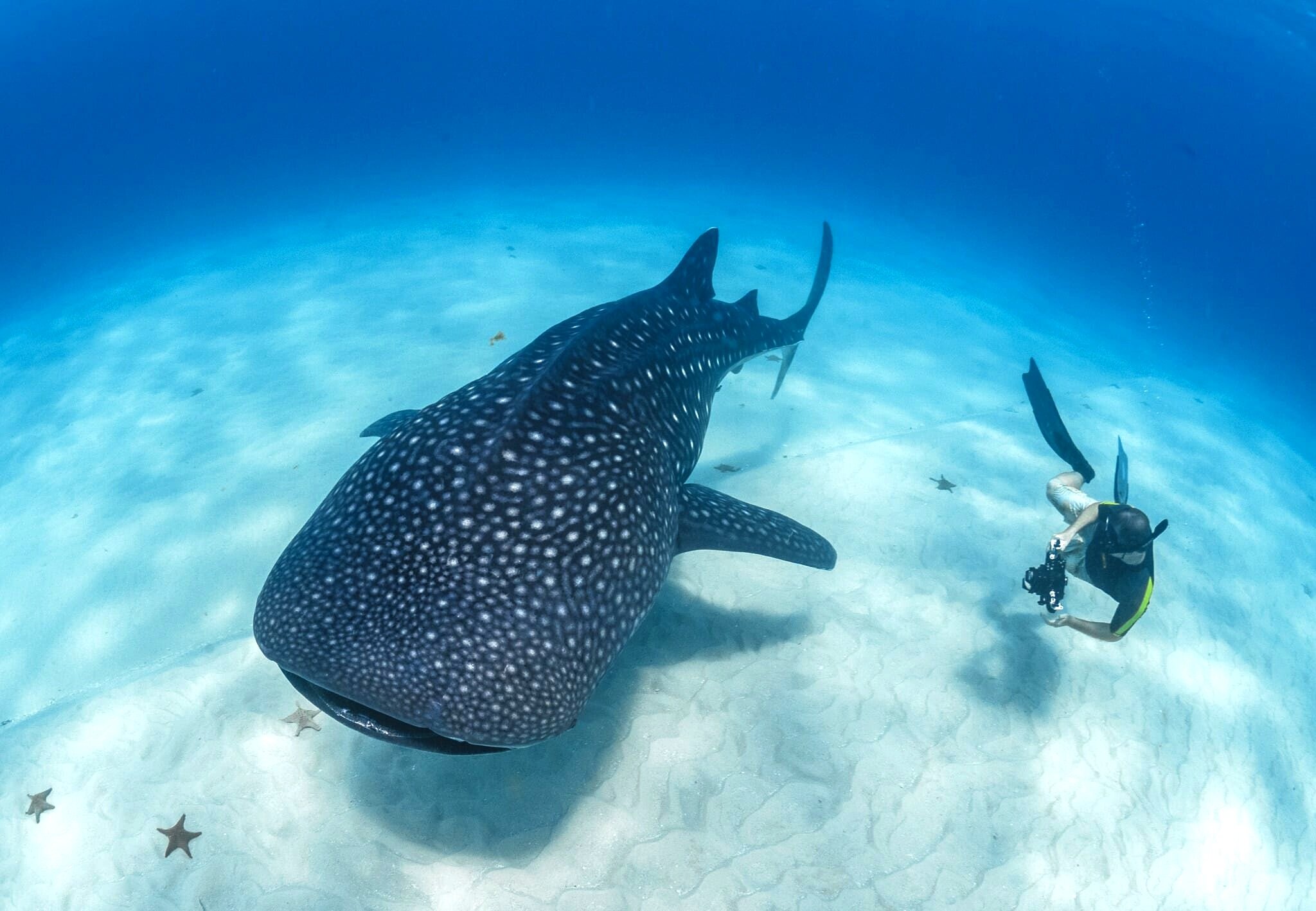Fluoro Fishies Enjoy Blacklight Discos. Honest.
Dr. Simon J Pierce is a co-founder of the Marine Megafauna Foundation, where he leads the global whale shark research program, and an award-winning marine wildlife photographer. About Simon.
Fluorescent lizardfish at Mafia Island, Tanzania
We live in a world of light and color. A large chunk of our brain is assigned to process the inputs received from our eyes. We appreciate beautiful sunsets, rainbows, and fairy lights.
Other mammals see a different world. Dogs don’t see the same range of colors we do, though their heightened sense of smell helps them to appreciate fox poop at a level that I just cannot reach.
Like theirs, our senses are optimized for a certain way of life. Our vision is among the sharpest of all mammals, but only during daytime; we need to turn on a light to see at night. We’re great at finding ripe fruit, but our eyes can’t process the ultraviolet patterns that flowers use to attract bees.
In the ocean, we’re hopeless. Our visual field is a big blurry mess, so we need a mask or goggles to correct it.
Fish, of course, live in that alien environment. Sounds can travel hundreds of kilometers underwater. The smell of land can help sharks orientate from far offshore. Even in the clearest water, though, horizontal visibility is measured in tens of meters. Sunlight only penetrates a narrow band at the top of the ocean. Colors are heavily filtered by water. Over half the visible light spectrum is absorbed within a meter of the surface. Everything becomes a uniform, monochromatic blue-green as you descend.
Juvenile whale shark in blue water at Darwin Arch, Galapagos
Forgive me, then, for assuming that fish vision would be boring. Some, in fact, live in a neon explosion of vivid technicolor.
I’ve recently been introduced to this world myself. With a blue torch and a yellow filter over my mask, I dived into the blacklight disco world of a Madagascan coral reef at night to view a phenomenon called “biofluorescence”. After that one dive, I bought all the various filters and lights needed to photograph this experience. It’s far too interesting not to share.
The photographs in this article show what the fish can see.
Sea anemone fluorescence under blue light at Nosy Sakatia, Madagascar
Most people are familiar with bioluminescence. Glow worms, fireflies, and even some mushrooms can produce light through a chemical reaction. Biofluorescence is different. That’s when an animal can absorb the short wavelengths of blue-green light, so common underwater, then re-emit that light at longer wavelengths to produce neon greens, reds, and oranges.
It’s difficult for us to see this. The pervasive blue light overpowers our own visual system. When we use a yellow filter to remove the blue, though… wow. Many biofluorescent fishes use the same trick: they have yellow filters in their own lenses and corneas. Their fluorescent emissions are invisible to us, and most predatory fishes, but strobe their presence to other fishes that share this adaptation.
It’s like invisible ink – a secret way to communicate without detection.
Fluorescing moray eel at Nosy Sakatia, Madagascar
Biofluorescence occurs in over 250 fish species, as well as hard corals, jellyfish, mantis shrimps, sea turtles, and other groups. It’s particularly common in “cryptic” species. Many coral reef fish species have vivid color patterns, like angelfishes. “Cryptics,” such as lizardfishes and scorpionfishes, appear well-camouflaged to our eyes.
A recent survey found that 87% of these cryptic fishes are biofluorescent, compared to only 9% of other fishes. They’ve got the best of both worlds – hidden from predators, but gorgeous to each other. Cryptic fishes are living their best lives.
Fluorescent lizardfish at Nosy Sakatia, Madagascar
Researchers are only starting to uncover the importance of biofluorescence in the ocean. Frogfish use fluorescent lures. Wrasses use biofluorescent displays during courtship. Triplefin use their red biofluorescent eyes to spotlight their copepod prey, whose eyes reflect the light, but cannot see it themselves. There’s a reason why spawning events are often closely connected to moon phase. Moonlight provides the right wavelengths for spawning fish to produce green and red biofluorescence, ensuring they’re getting sexy with the right species.
Fluorescing coral at Nosy Sakatia, Madagascar
Biofluorescence requires light to enable the process, so it’s most common n shallow reef systems. Still, life will find a way. Some deepwater species, such as the “deep-sea loose-jaw dragonfish” – which gets a gold star for its name – even produce blue light through bioluminescence, then re-emit that light as red biofluorescence to improve their hunting success.
This knowledge of biofluorescence is useful to us, too. The Nobel Prize in Chemistry for 2008 went to a team that used a fluorescent protein from jellyfish to transform the imaging of everything from brain structure to the AIDS virus.
Conservation, too, can benefit. Over half the fish species living on coral reefs are those small, difficult to find “cryptics”. Standard fish counts can grossly underestimate the true biodiversity that’s present. Most of those small species are biofluorescent, though, so they light up like a nineties raver for divers with the right equipment. That leads to faster and better reef surveys.
Fluorescing mushroom coral at Mafia Island, Tanzania
Fish biofluorescence is incredibly variable. It can occur as neon green mucus, to simple eye rings, to complex patterns of color in otherwise nondescript fish. That diversity, and its occurrence within unrelated groups – from sharks to chameleons, and even parrots can have biofluorescent beaks – suggests it has evolved independently many times. It’s clearly useful to these animals. It seems like we’re finally starting to see the light, too.













